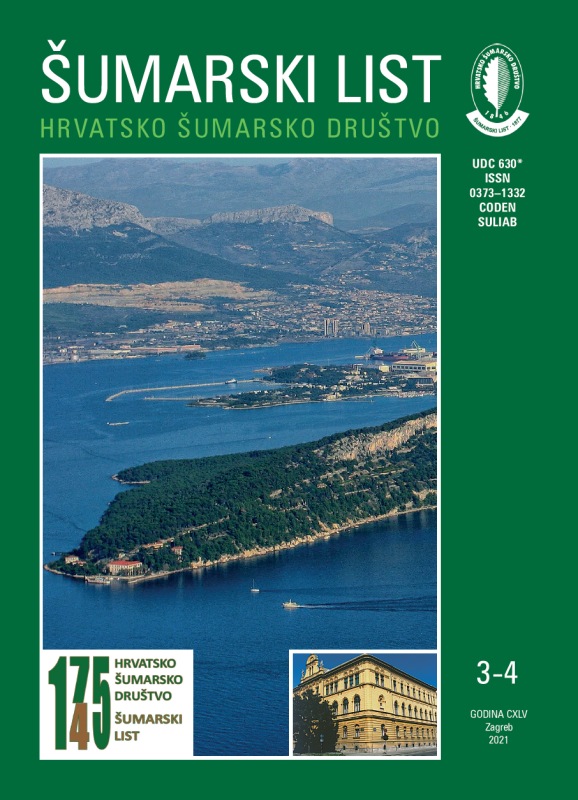
broj: 3-4/2021
pdf (11,5 MB) |
|
||||||||||||||
| RIJEČ UREDNIŠTVA | ||
| Uredništvo | ||
| Misunderstanding pdf HR EN | 113 | |
| IZVORNI ZNANSTVENI ČLANCI | ||
| Dino Hadžidervišagić, Azra Čabaravdić | UDK 630* 272 (001) https://doi.org/10.31298/sl.145.3-4.1 | |
| Importance and structural diversity of trees in a historical park pdf HR EN | 117 | |
| Dušan Jovanović, Milan Gavrilović, Mirko Borisov, Miro Govedarica | UDK 630*902 (001) https://doi.org/10.31298/sl.145.3-4.2 | |
| Deforestation monitoring with Sentinel 1 and Sentinel 2 images – the case study of Fruška gora (Serbia) pdf HR EN | 127 | |
| PRETHODNO PRIOPĆENJE | ||
| Boris Miklić, Anja Žmegač, Domagoj Trlin , Marko Orešković, Stjepan Mikac, Igor Anić | UDK 630* 111.8 https://doi.org/10.31298/sl.145.3-4.3 | |
| Climate sensitivity of black pine (Pinus nigra Arnold.) chronology in the Northern Velebit pdf HR EN | 137 | |
| Jelena Kranjec Orlović, Ida Bulovec, Milivoj Franjević, Damjan Franjević, Josip Skejo, Marin Biliškov, Danko Diminić, Boris Hrašovec | UDK 630*232.3 + 442 https://doi.org/10.31298/sl.145.3-4.4 | |
| Preliminary results on narrow-leaved ash (Fraxinus angustifolia Vahl) and green ash (Fraxinus pennsylvanica Marshall) seed entomofauna in Croatia pdf HR EN | 147 | |
| Mirjana Stevanov, Albina Tarjan Tobolka, Ljubomir Kljajić, Martina Kičić, Max Krott | UDK 630*903 https://doi.org/10.31298/sl.145.3-4.5 | |
| Analysis of conflicing interests on the example of the special nature reserve in Serbia: empirically analytical approach pdf HR EN | 155 | |
| Summary This study, based on modified Schusser´s sequential method, was conducted from August 2017 to August 2018 with the aim of using accessible and familiar case example from Serbia to verify the claim of forest policy science - that users, their interests and potential conflicts of interest can be comprehensively identified and analysed while applying empirically analytical approach. On the example of special nature reserve Koviljsko-Petrovaradinski Rit the intensity of user´s interest is assessed based on qualitative content analysis and critical reasoning in combination with the techniques of triangulation, induction and deduction. By entering the estimated intensity of user interests into the analytical sheme (users categorized as forest owners- state/province and private, forestry employees, enterprises/institutions and citizens), the first conflicting zone was identified between the very strong interests in forest utilization (priority of profitable timber harvesting) and the interest field comprising the very strong and strong user interests for nature conservation. In addition, the state/province (public enterprise Vojvodinašume) is in an internal conflict, having (also) a very strong interest in wood production (creating revenues) on the one hand and in nature conservation on another. In order to balance them (towards the general social interest), the state/province has an advantage of being in the position to look internally for a solution, but the analytical scheme also shows how potential changes could trigger conflicts with other users (wood industry if protection is increased or nature protection actors if logging intensifies). The current solution of protection zones, divided into strict protection 6%, active protection 29% and profitable use of wood 65%, reflects the actual compromise package between the state/province andinterests of remaining users, which will last as long as the state/province is in the position to support it with available political means. Whereas individual discourses take into account only partial aspects, the current approach has provided a comprehensive insight into Rit´s actors and interests. Methodological set-up of existing theoretically-based analytical categories has offered conclusions relevant for further research, forming at the same time a strong basis for more active communication of results with practice: users can more clearly perceive each other’s positions and evaluate own abilities to act, while searching for the implementation concepts that work in practice. Key words: interests; conflicts; protected areas; forest policy; Serbia | ||
| Erol Akkuzu, Mustafa Şahin, Abdullah Ugiş, Ebru Bal | UDK 630* 453 https://doi.org/10.31298/sl.145.3-4.6 | |
| Assesment of trap color and trap height above the ground on the capture of Ips sexdentatus and Thanasimus formicarius pdf HR EN | 169 | |
| PREGLEDNI ČLANCI | ||
| Damir Barčić, Vlado Habjanec, Željko Španjol, Mario Šango | UDK 630* 111.5 + 421 https://doi.org/10.31298/sl.145.3-4.7 | |
| Analysis of raising windbreaks on the mediterranean karst of Croatia pdf HR EN | 175 | |


